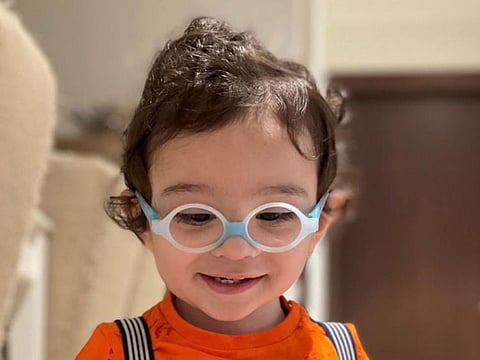Surgery in Abu Dhabi corrects crossed eyes in 11-month-old Adam
Crossed eyes affect 4% of children, presenting vision and psychosocial concerns

Abu Dhabi: A corrective eye procedure has helped correct 11-month-old Adam’s crossed eyes, with doctors at Cleveland Clinic Abu Dhabi insisting that such procedures provide both physical and psychosocial benefits.
Adam’s parents first noticed that his eyes were not properly aligned when he was just two months old. They were concerned that it could be a sign of a more serious visual impairment, they began consulting doctors to find the reason for the misalignment.
“At first we thought it might just be that newborn’s eyes aren’t always fully aligned. However, after another month or so, we were quite concerned it could be more than that. As a parent, you want your child to have the best chance of understanding the world around him and not feel isolated or unable to interact. That’s when we began consulting doctors,” said Mohamad El Jammal, Adam’s father, an expat from Lebanon.
“The immediate problems children can experience because of poor binocular vision in terms of things like fine motor control and academic achievement are generally well understood. However, the psychosocial effects are less talked about. A child with misaligned eyes is seen and treated differently by other children overtly and even by adults, even if only at a subconscious level. This affects a child’s self-esteem, confidence and personality development. Beyond the benefits to vision, correcting an eye turn means giving a child the best possible chance in life,” said Dr Arif Khan, a paediatric ophthalmologist at Cleveland Clinic Abu Dhabi.
Comprehensive eye exam
Adam’s care team began with a comprehensive eye exam to determine the extent of his eye turn and rule out any further eye conditions that could be causing it. Not finding any, they began by fitting him for glasses to see if the strabismus could be corrected without surgery. Regular follow-ups over the next few months confirmed that while the glasses had improved Adam’s condition, surgery would be required to fully correct it.
Adam's condition
Adam has strabismus, which is one of the most common paediatric eye conditions identified by doctors. It is known to affect four per cent of children, and is marked by a misalignment of the eyes. As a result, the brain uses only one eye at a time, rather than both together for full binocular perception. Left uncorrected, strabismus can affect fine motor control, depth perception, hand-eye coordination and even reading speed. The condition also affects children’s psychosocial health, reducing confidence, sociability and academic ability.
“Adam had good vision but rather than using his eyes together, he was using one at a time. It was crucial that we operated on the eyes as early as possible while the brain-eye connection was still developing. By performing the surgery early, we give him the best chance for the right connections to develop between the eyes and the brain, allowing him to take in the world with both eyes at once,” Dr Khan said.
When Adam was still only 11 months old, he underwent ambulatory eye muscle surgery. During the 40-minute operation, his eye muscles were repositioned to compensate for the eye turn. By realigning his eyes, the aim was to allow the brain to lock in the new straight-ahead position as the correct one.
Improvement immediately apparent
Following the surgery, the improvement in Adam’s vision was almost immediately apparent to his parents.
“Immediately after the surgery, you could feel Adam was happier and more relaxed. He was more interactive with us because his field of view became bigger. We really noticed he was quite excited about it for a couple of days. Now he’s running around the house, happy with the world around him. I really want to tell parents in a similar situation not to delay or leave it to chance — the earlier you speak to a doctor, the better,” El Jammal said.
Doctors at Cleveland Clinic Abu Dhabi recommended that all children have an initial eye exam at about the age of four to rule out any vision-related issues, but this can always be carried out earlier if the parents have specific concerns at an earlier age.
Sign up for the Daily Briefing
Get the latest news and updates straight to your inbox









